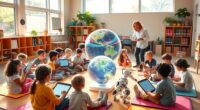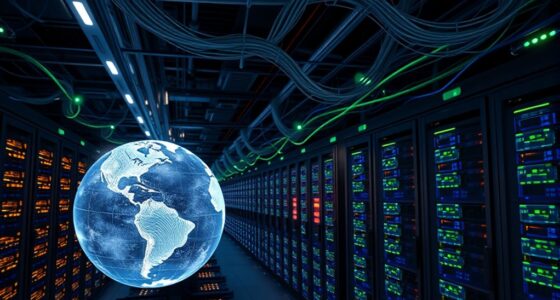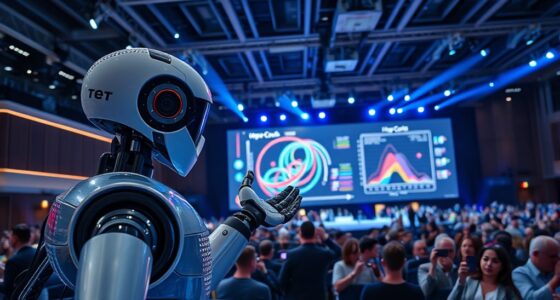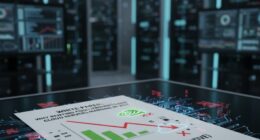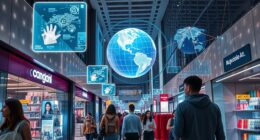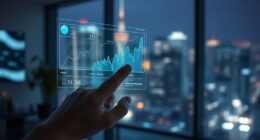AI is transforming creativity by acting as a powerful idea generator and tool, but it won’t fully replace your imagination and originality. It helps you generate new concepts, automate routine tasks, and explore innovative styles, yet human intuition, emotional insight, and critical thinking remain essential. As AI becomes more integrated into creative fields, understanding how to work alongside it will become crucial. If you’re curious about how to harness AI’s potential while preserving your unique voice, keep exploring.
Key Takeaways
- AI excels at generating novel ideas and patterns but lacks the emotional depth and contextual understanding of human creativity.
- Increased AI use can lead to idea saturation, reducing the originality and uniqueness of creative outputs.
- Human skills like strategic thinking, emotional intelligence, and cultural insight remain essential alongside AI tools.
- Ethical, legal, and authenticity concerns challenge AI’s ability to fully replace human artistic expression.
- AI serves as a tool to enhance rather than replace human creativity, fostering collaboration and new artistic possibilities.
The Impact of AI on Human Idea Generation and Thinking Skills

While AI can generate ideas that are often more exciting and unique than those from humans, it doesn’t necessarily boost your individual thinking skills or creativity. Large-scale studies show that exposure to AI-generated ideas doesn’t *considerably* enhance your own creative output. Even if you’re highly creative, knowing an idea is AI-driven doesn’t make you more inventive. Instead, people tend to adopt AI ideas when tasks are tough, relying more on external input than developing ideas from scratch. As the number of AI-generated ideas increases, their originality tends to decline, indicating saturation. So, while AI can provide fresh concepts, it doesn’t directly improve your personal ability to think creatively or develop new ideas independently. Additionally, the presence of external input can sometimes hinder the development of original thoughts. Recognizing the limitations of AI creativity is essential for understanding its role in the broader landscape of human innovation. Moreover, reliance on AI-generated content may reduce opportunities for deep, original thinking that often leads to breakthroughs. Incorporating mindfulness techniques can help foster a more focused and reflective mindset that supports genuine creativity. Understanding the importance of creativity techniques can also help individuals cultivate their unique problem-solving skills.
How AI Functions as a Creative Partner, Not a Replacement
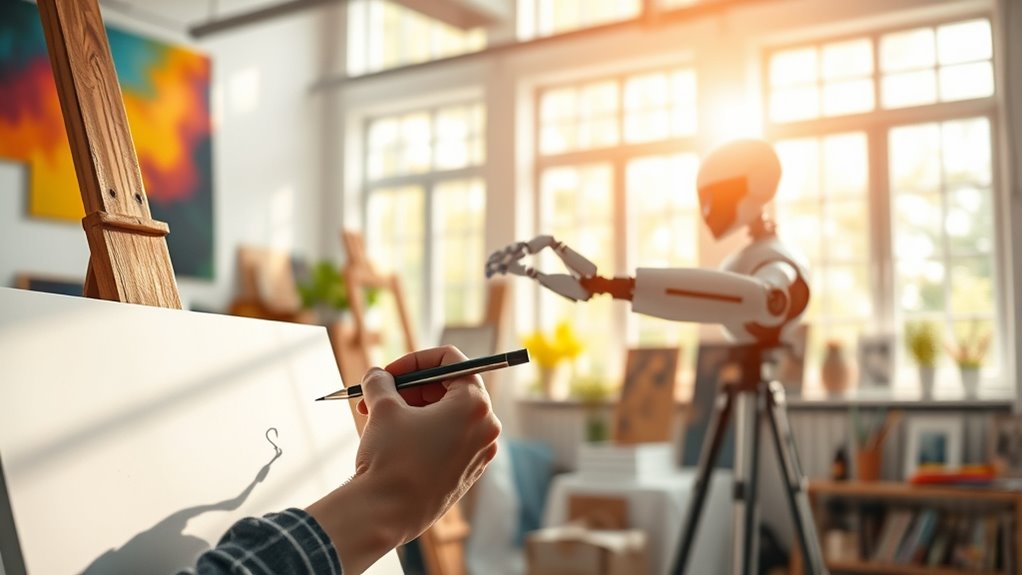
AI serves as a valuable creative partner by enhancing your ability to generate ideas, analyze data, and explore new concepts. Instead of replacing you, AI amplifies your strengths and handles routine tasks, so you can focus on core creativity. Here are three ways it supports your work:
AI amplifies your creativity by handling routine tasks, inspiring ideas, and personalizing your work for greater impact.
- Automates repetitive tasks, freeing your time for innovation.
- Acts as an idea generator, providing unexpected suggestions to inspire you.
- Personalizes outputs, tailoring content to your audience while you retain strategic control. Embracing AI as a collaborative tool allows designers to leverage advanced adjustments and instant mockups, streamlining the early stages of project development. Understanding regional legal resources can also help creatives and professionals navigate complex environments more effectively. Additionally, integrating Water-related knowledge can improve project planning and resource management in various creative and operational contexts. Recognizing the importance of vetted information ensures that creative decisions are based on accurate and reliable data. Acknowledging individual responses to divorce can help tailor emotional support strategies to meet specific needs. Moreover, incorporating Sleep and mental health awareness can contribute to overall well-being, enhancing productivity and creativity.
The Growing Role of AI in Creative Industries and Future Challenges

The integration of artificial intelligence into creative industries is accelerating rapidly, transforming how artists, designers, and content creators work. Generative AI is fueling new business models and expanding opportunities, with AI-generated art projected to make up 5% of the contemporary art market by 2025. The sector is growing over 30% annually, and 78% of organizations are using AI in 2024—up from 55%. Markets for AI video and image creation are booming, expected to reach billions by 2032. Additionally, advances in AI-generated art are challenging traditional notions of creativity and skill, prompting discussions about the future roles of human artists. However, this growth brings ethical and legal challenges, such as questions about authenticity, authorship, and misinformation. Cultural acceptance is rising, with AI art exhibitions increasing 25% in three years. Future challenges include balancing innovation with ethical standards and redefining creative roles amidst ongoing technological advancements. Additionally, understanding personality traits and how they influence user engagement can help shape more ethical AI applications in creative fields. Recognizing the importance of Paint Sprayer Maintenance and Troubleshooting can also provide insights into maintaining the integrity and quality of creative outputs in technical applications. As the industry evolves, ongoing dialogue about ethical considerations will be essential to navigate the complex landscape of AI-driven creativity, especially as public perception continues to shift with technological progress.
Shifts in Human Creativity and the Need for New Skills
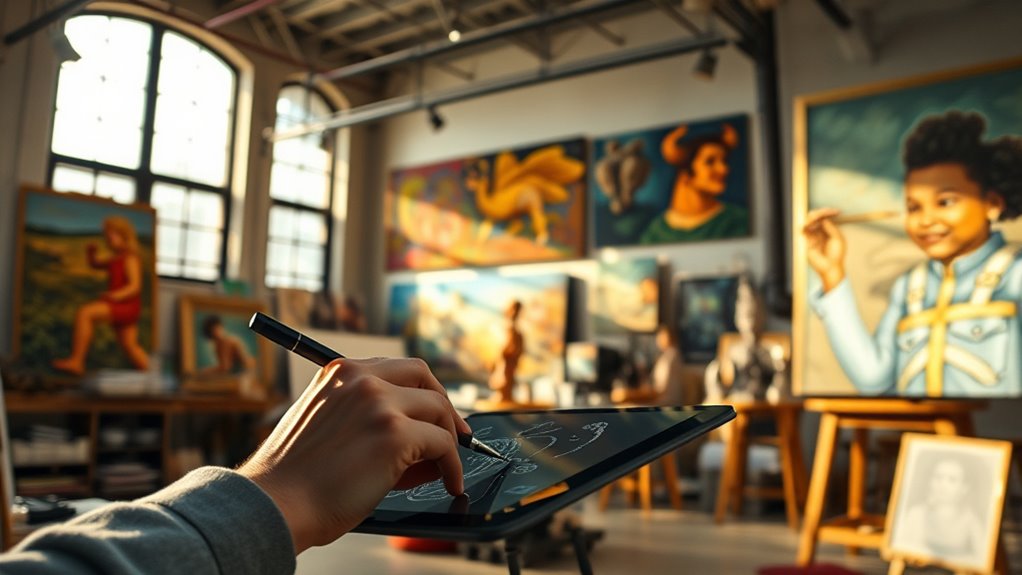
As creative tasks become more automated, human roles are shifting toward higher-level activities like strategic planning, community engagement, and overseeing the creative process. You’ll find yourself focusing on orchestrating ideas, ensuring authenticity, and guiding AI outputs. To succeed, you need new skills:
- Data Analysis and Interpretation: Making sense of AI-generated insights to inform creative decisions. Subtopic 3: New Approaches to Data and AI Utilization emphasizes that data and AI are being used not just for content production but as strategic directions, highlighting the importance of understanding data in creative work. Recognizing the role of nutrition and brain health can also support cognitive functions necessary for analyzing complex data sets. Developing a noise-conscious mindset can further enhance your ability to integrate AI tools without disrupting team dynamics or audience experiences. Additionally, understanding automation in business can help you identify opportunities to optimize workflows and leverage AI for more effective creative management. Moreover, cultivating critical thinking skills is essential to evaluate AI outputs critically and maintain creative integrity.
- Strategy and Innovation: Developing innovative concepts and planning beyond routine tasks.
- Emotional Intelligence: Connecting with audiences emotionally and understanding consumer needs.
These skills enable you to leverage AI tools effectively while maintaining a human touch. As the landscape evolves, your ability to blend technology with creativity will determine your relevance and value in the future of work.
Collaborating With AI: Opportunities and Ethical Considerations
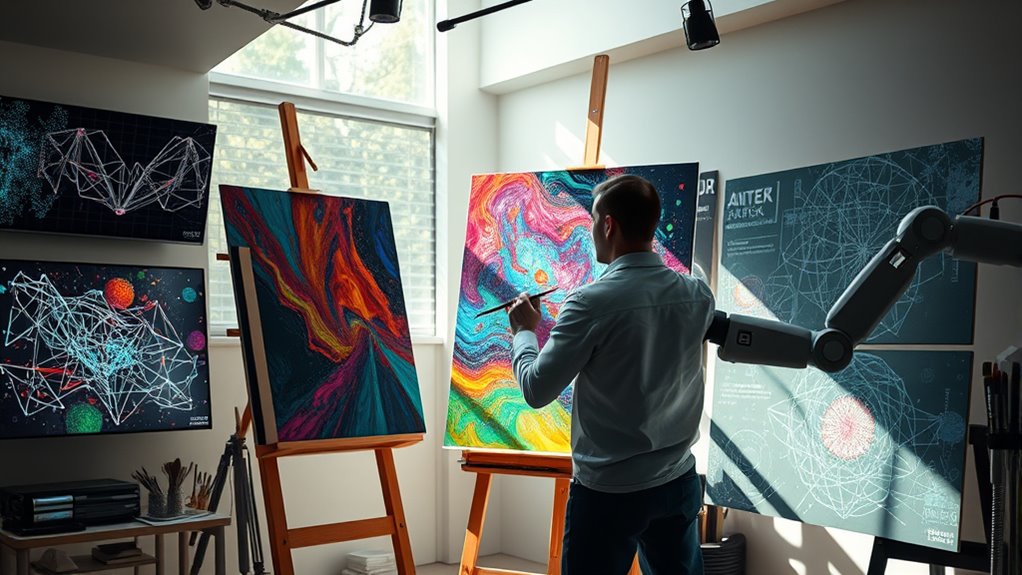
Collaborating with AI offers exciting opportunities to enhance creativity and push boundaries in various artistic fields. Over 83% of creatives already incorporate AI into their workflows, showing its widespread adoption. AI helps you overcome creative blocks by suggesting new ideas and analyzing audience trends, opening fresh possibilities in art, music, film, and storytelling. It acts as a catalyst, detecting subtle patterns and generating suggestions you might overlook, enabling innovative directions. Human-AI partnerships can produce avant-garde works that are difficult or impossible alone. These collaborations not only boost productivity and efficiency but also inspire new artistic styles and forms. The integration of AI tools has transformed traditional creative processes, leading to more dynamic and experimental projects. However, ethical considerations arise around attribution, transparency, bias, and intellectual property, requiring ongoing scrutiny to ensure AI enhances human creativity without compromising integrity.
Frequently Asked Questions
Can AI Truly Understand Human Emotions Behind Creative Works?
You wonder if AI can truly understand human emotions behind creative works. Currently, AI analyzes facial expressions, voice tones, and text sentiment to infer feelings, but it doesn’t experience emotions itself. It predicts and mimics patterns, providing useful insights and enhancing creativity. However, it lacks the depth of genuine emotional understanding, cultural nuance, and subconscious drives that make human creativity unique. So, AI can assist but not fully grasp human emotional complexity.
How Can Educators Adapt to Ai’s Influence on Student Creativity?
Imagine guiding a ship through uncharted waters, where AI is both a compass and a storm. To adapt, you set clear rules, balancing AI tools with traditional methods. Encourage students to critically evaluate AI outputs, fostering their own ideas. Promote collaboration, reflection, and ownership in projects. By doing so, you guarantee that AI enhances creativity without overshadowing the human spark, steering your students toward innovative, authentic expression.
What Are the Long-Term Societal Impacts of Reduced Independent Thinking?
You might worry about long-term societal impacts when independent thinking declines. It could lead to less innovation, weaker problem-solving skills, and decreased adaptability in facing global challenges. Over time, this reliance on others’ ideas and AI may hinder personal growth, reduce social cohesion, and weaken democratic processes. To combat this, you should prioritize fostering critical thinking, encouraging autonomy, and promoting activities that develop problem-solving and creativity skills.
Is There a Risk of AI Reinforcing Existing Biases in Creative Content?
Isn’t it ironic how AI, a tool meant to innovate, risks becoming a mirror reflecting society’s flaws? You should know that AI can reinforce biases in creative content, as it inherits stereotypes from biased data. This means you’ll see more gender, racial, and cultural stereotypes, which can shape perceptions negatively. To prevent this, transparency and diverse data sources are essential, ensuring AI supports fairness rather than perpetuating prejudice.
How Will AI Shape the Future of Artistic and Cultural Diversity?
AI will substantially shape the future of artistic and cultural diversity by introducing new styles, forms, and experimental avenues. You’ll see more innovation and broader representation, but also face challenges like bias and debates over authenticity. As you engage with AI art, you’ll notice a mix of expanding creative boundaries and ongoing concerns about legitimacy, ethics, and legal issues. Embrace its potential while staying aware of its complexities in shaping culture.
Conclusion
As you explore AI’s role in creativity, remember that over 60% of artists now use AI tools to enhance their work. AI isn’t here to replace your unique ideas but to serve as a collaborative partner. Embrace these new opportunities and develop skills that integrate technology seamlessly. By doing so, you’ll stay ahead in a rapidly evolving landscape, turning challenges into innovative possibilities rather than threats.

